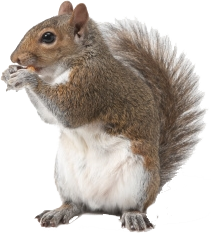
FAQs
Squirrel
FACTS AND QUESTIONS
How do I get this skunk smell out of my house?
We recommend opening the windows immediately following a skunk spray to allow as much of the smell as possible to be vented outside before it has time to bond to fabrics and materials. Placing bowls of vinegar, open bags of charcoal and air sponges, throughout the home to decrease the severity of the smell, often helps.
How did a bat get into my house?
For this answer and many other interesting things about bats see our bat page.
Are the animals in my attic doing any damage?
Yes! Animals living in the attic can cause several different types of damage. Their urine and feces cause odour problems, electrical shorts and stains on ceilings and walls. Often animals die in their living area and down walls, creating terrible odour and insect problems. Previously occupied areas make for attractive den sites to animals that come by in the future. Wiring is also a large concern because squirrels and raccoons have a tendency to chew on it causing electrical shorts and or fires. This is why prevention is so important. All of the above is much more costly to repair then the job of just getting them out and keeping them out.
Is Live Trapping a good idea?
Live trapping is probably one of the worst ideas for solving a wildlife problem. There are lots of reasons why trapping is a bad idea.
- Live traps are not targeted to a specific animal. You may catch an animal, but not the one causing the problem. You could catch one of five animals living in a specific area. Or you’ll catch everything but the raccoon your after like skunks, cats, oppossum etc.
- Setting a trap and relocating a nursing mother can cause several babies to starve and die in a chimney or inside of walls. This causes terrible odour problems. Individuals or companies that relocate nursing animals cause problems for the homeowners because they are stuck with the crying starving orphaned young.
- Trapping does not fix the real problem. Placing a trap to catch an animal does not repair the area that the animal is using as a den site. These opportunistic animals get into chimneys, attics, under additions, sheds, decks etc. These areas are so attractive and inviting that if you take an animal away, the area will attract a new host. You need to solve the real problem. Once you understand that the structure is the problem and not the animal the solution makes perfect sense.
- If a nuisance animal has been trapped previously it is less likely to ever enter a trap again.
- It is illegal to relocate wildlife farther than 1 km from the capture site.
- Mothers trapped and relocated with their young will often abandon their babies because of the highly stressful trapping and relocation process.
Do mothballs, Peppers, ultrasonic devices, or other deterrents really work?
No they don’t. We see numerous attempts to discourage animals, the best way is a permanent fixture or barrier that prevents the animals from gaining access. This is why we specialize in exclusion and prevention.
